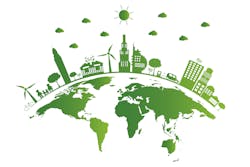As the threat of climate change becomes increasingly prominent, sustainability is driving many new infrastructure projects. Environmental groups and government agencies push for green transformation, but must also support a growing population and expanding nation. Net-zero communities are a potential answer to these issues.
Renewable sources like wind and solar let net-zero communities generate as much energy as they consume. As they become more popular, more contractors and HVAC professionals will have to consider how to facilitate sustainable living. After all, people can’t become carbon-neutral if their homes and communities don’t enable it.
The majority of Americans believe the government should prioritize protecting the environment, and the U.S. is the second-largest energy consumer globally. This unique situation will likely drive more net-zero community development. Here’s how these communities can achieve their goals and what’s in store for them in the future.
The Appeal of Net-Zero Communities
One of the most crucial aspects of a net-zero community is that it’s an area-wide effort. A single building can reduce its power consumption through things like better insulation, but it’s still challenging to generate energy. When planners and contractors approach sustainability through a community-wide lens, this isn’t as much of an issue.
Some parts of an area are ideal for generating power, while others are better at saving it. It would be difficult for an energy-intensive building like a lab to achieve net-zero status on its own. If that facility were part of a community that generated excess green power, it could reduce its environmental impact more easily.
Enabling net-zero energy consumption frequently involves unique plumbing, wiring and HVAC challenges. Approaching these at a community level instead of a single building is less disruptive.
Renewable Energy
The first step in creating a net-zero community is establishing a renewable energy network to power it. Solar photovoltaics is the standard answer to this problem, and it’s easy to see why. It costs just 6.8 cents per kWh on average and is readily available in virtually every area.
Energy generation affects more than just an area’s electrical grid, too. Some forms of power require a lot of water for cooling, leading to increased work and plumbing infrastructure considerations. By contrast, widespread solar power could save enough water to hydrate 1.3 million homes in the U.S.
Passive solar energy can also handle things like heating without any electricity. Solar chimneys, glass walls and metal water tanks can help heat buildings without consuming more of an area’s power supply.
Reducing Energy Waste
Of course, sourcing power from a renewable source is only part of net-zero community development. For all their benefits, renewables typically aren’t as efficient as fossil fuels, so reducing energy waste is essential. The less power buildings lose, the less electricity the area will have to generate.
Water heating accounts for 18% of home energy use, on average. It wouldn’t consume nearly as much if architects and planners considered energy waste in plumbing from the beginning. Better pipe insulation and heat-retaining materials would drastically reduce heat loss in community plumbing systems.
Similarly, improved insulation in buildings could prevent energy loss from heating systems. The materials needed for reduced energy loss may cost more upfront, but they’ll lead to long-term savings. Measures like insulation and air sealing can lead to a substantial reduction in energy spending.
Water Conservation
Conserving water is a crucial step in sustainability, but isn’t often part of the conversation about energy use. Still, it takes power to pump water, so the less water a community uses, the less energy it will consume. As net-zero communities grow, they’ll have to pay attention to how they use water.
One of the most straightforward improvements in this area is the implementation of eco-friendly toilets. Toilets consume more water than anything else in a home, so low-flow options could drastically reduce energy usage. Some researchers have even tested the viability of waterless toilets, but homeowners may be uneasy with this concept.
Flow-optimized faucets could also help reduce water consumption, and thus, energy use. These approaches also highlight how net-zero communities are typically more efficient than individual green buildings. While these improvements don’t contribute much to sustainability by themselves, together, they amount to impressive savings.
Sustainability by Design
As more construction companies take on net-zero community projects, they must avoid designing traditional areas and adding green technologies. Instead, the communities of tomorrow should showcase sustainability by design. The very structure of these buildings and infrastructure should enable green living.
As mentioned earlier, innovative home design can accommodate energy-free heating. Glass walls standing opposite those made of heat-reflective materials can warm areas without electricity. Architects and designers can apply the concept behind solar chimneys to an entire hallway or even building.
Minimizing air leaks by passive home design will further conserve energy in heating, especially in colder areas. For the warmer months, natural shading can provide power-free cooling. Other design steps, like using solar roof tiles instead of installing an array of external panels, can push sustainability-by-design further.
Paving the Way for Larger Net-Zero Communities
As of 2019, there were 81 net-zero communities in the U.S., with more than 400 more under construction. This trend is skyrocketing, and as it does, these projects will grow, not just in number but in size. The net-zero communities of tomorrow will be far more extensive than those existing today.
Larger communities may seem like a more considerable challenge, but they come with unique opportunities. The net-zero approach could expand past residential areas and into stores, offices and even agriculture. As these communities become larger, they can become entirely self-sufficient, not just in energy.
Some communities are already venturing into this area, like Hawaii’s Kaupuni Village, which features an aquaponics system, sustainably growing its own produce. Thanks to these self-sufficient features and practices like using recycled building materials, the houses in Kaupuni Village are considerably more affordable than the median in Oahu. This affordability could attract more residents, making these projects even more popular and helping them expand.
In Wisconsin’s Red Fox Crossing, homes cost more than traditional houses, but energy savings make up for the difference in roughly seven years, appealing to more customers. In fact, despite higher costs, Red Fox Crossing has sold at least 20 of its 34 houses, making it one of the largest net-zero communities in the nation. So as long as communities emphasize the long-term benefits of their houses, upfront costs may not limit their expansion.
The developers of future net-zero communities need to start considering how to enable net-zero business and municipal systems. Powering neighborhoods with local energy won’t be enough in the future as more people move into these areas. These communities must also feed themselves and become economically independent, making them more viable for a wider range of people.
Green Futures Start Today
This sustainable, self-sufficient future may seem far off, but it requires action in the present. By thinking of the future today, companies can start to create the cities of tomorrow. The move to net-zero communities is inevitable, and it begins now.
Rose Morrison is a freelance writer who covers construction, home improvement, and contracting topics. She is also the managing editor of Renovated.com, a site dedicated to the latest trends in the home industry. She has a passion for innovative technologies that are making the home industry sustainable and efficient. Check out Renovated.com to see more of her work.
About the Author

Rose Morrison
Rose Morrison is a freelance writer who covers construction, home improvement, and contracting topics. She is also the managing editor of Renovated.com, a site dedicated to the latest trends in the home industry. She has a passion for innovative technologies that are making the home industry sustainable and efficient. Check out Renovated.com to see more of her work.
